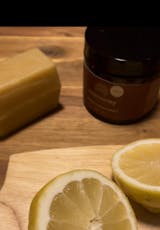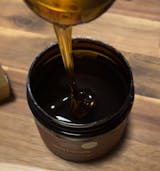Honey has been used to heal humans across different cultures for centuries. Its range of healing properties is determined by the floral source and the health of the bee colony that produces the honey that we consume. So what makes apia honey's healing properties unique?
Native to Western Australia, Jarrah and Marri trees produce a medicinal honey containing high levels of anti-bacterial, anti-inflammatory and anti-microbial activity within it.
These trees have remained untouched by humans for centuries in environments protected by national parks, state forests, and private farm land. Our bees forage on these tree flowers, and during the honey making process, an enzyme called glucose oxidase gets picked up by the bees and converts glucose into hydrogen peroxide.
It is this naturally occurring level of hydrogen peroxide that makes our honey so powerful as a healing mechanism, especially when compared to the other floral sources available to the bees. (shown in the graph opposite)
The level of activity of these enzymes in Jarrah and Marri honey are identified and measured independently by scientists which results in an overall honey activity index, referred to as "TA" or Total Activity, the larger the number the stronger the antibacterial qualities in the honey. Continue reading below to learn more.

“Exceptionally high activity was also seen in hydrogen peroxide-dependent honeys derived from marri and jarrah from Western Australia. To our knowledge these are the most potent antibacterial honeys yet reported.”
Total Activity = peroxide activity + non peroxide activity
Due to the hydrogen peroxide activity in Jarrah and Marri honey, our honey is rated by TA. See the basic rating translation on the chart opposite.
Common methods of rating manuka honey such as UMF (Unique Manuka Factor) and MGO (methylglyoxal mg/kg) only measure the non peroxide activity in the honey referring to the Methylglyoxal active enzyme.
“Honeys with hydrogen peroxide-dependent activity are more effective than manuka honey at inhibiting dermatophyte fungi and species of the yeast Candida, indicating that these honeys may be more broad spectrum and valuable as antifungal agents than manuka honey.”

As a state, WA takes its bio security very seriously which in turn creates a natural environment for bees to remain healthy and safe from other pests and diseases. Our hives have been methodically positioned across south western WA forests, surrounded by jarrah and marri trees, and isolated from major civilization.
While location and environment play big roles in determining the quality of any honey, we know our location—WA, makes Apia Honey some of the cleanest and safest in the world.
This is largely due to western australia's biosecurity and agriculture management act, which strictly monitors and limits goods coming into the state. This act has protected WA's clean environment from invasive species and foreign diseases, ultimately preserving agriculture and fostering healthier bees to flourish and produce this medicnal honey.

apia honey benefits

antimicrobial activity of honey is due to the glucose oxidase, hydrogen peroxide, and some phenolic compounds such as pinocembrin and syringic acid

antioxidant benefits of honey are associated with the presence of polyphenols including gallic acid, catechins, epicatechins, chlorogenic acids, caffeic acids, and quercetin

Jarrah & Marri honey is low in glucose/high in fructose compared to other honey which makes it low GI and wont spike your blood sugar making it a healthy sweetner option

Studies have shown that natural honey is a good source of prebiotics as it contains oligosaccharides (complex sugars) and other components that help to feed the beneficial microbes living in our gut, improving our gut microbial balance, which is directly linked to our overall health and wellness.

Honey coats the inner lining of the throat and destroys the harmful microbes while simultaneously soothing the throat. It is useful for the treatment of many oral diseases, including periodontal disease, stomatitis, and halitosis abd also helps with the prevention of dental plaque, gingivitis, mouth ulcers, and periodontitis.

Honey has hygroscopic properties, absorbing metabolites, and causing detoxification of the dermal tissue. This results in an increase in the skin tension, improvement of its elasticity, revitalizing its color, and smoothing out wrinkles while supporting skin-cell turnover, collagen and elastin production.

high levels of flavonoids and other polyphenols in honey helps to decrease inflammatory mediators by inhibiting the activation of the inflammatory response.

promoter of wound repair and an antimicrobial agent as honey promotes the activation of dormant plasminogen which activates the proteolytic enzyme in the wound matrix

honey helps by coating the esophagus and stomach lining, thus preventing the upward flow of food and gastric juice. Honey can further stimulate the tissues on the sphincter to assist in their regrowth and finally reduce the chances of acid reflux
head over to our news page to read more articles and further your knowledge with our library of articles & resources.


 AUS
AUS



































































